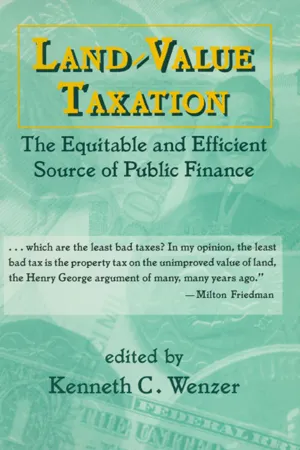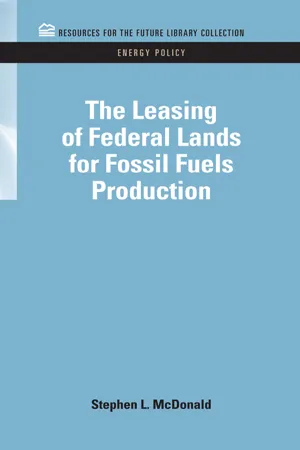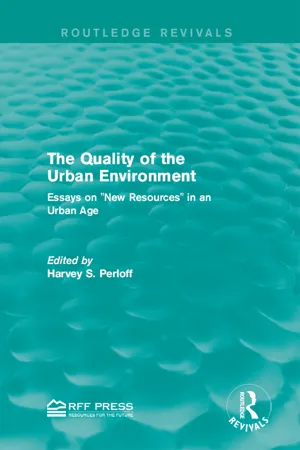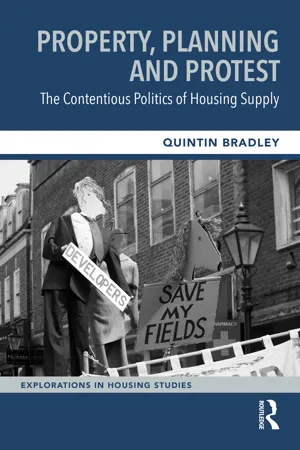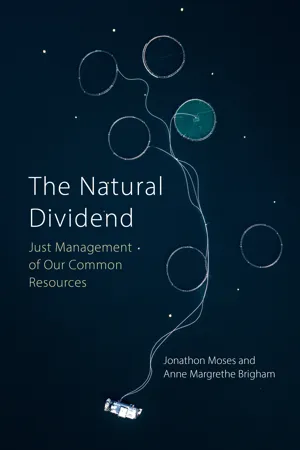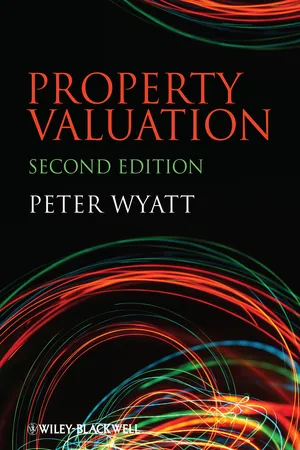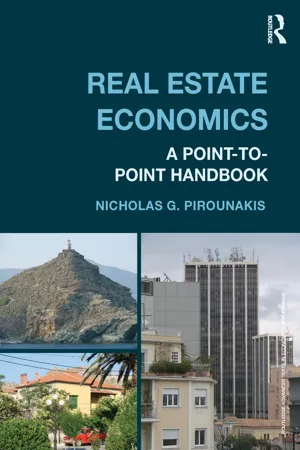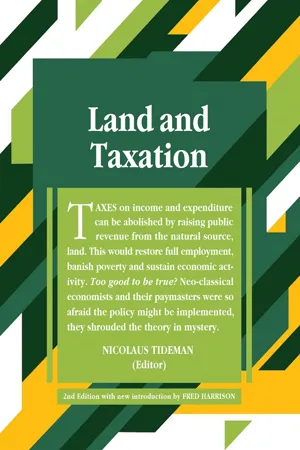Economics
Land Rent
Land rent refers to the payment made for the use of land. It is the income earned by landowners for allowing others to use their land. The amount of land rent is influenced by factors such as location, fertility, and natural resources. In economics, land rent is a key concept in understanding the allocation of resources and the pricing of land.
Written by Perlego with AI-assistance
10 Key excerpts on "Land Rent"
- eBook - ePub
Urban Land Rent
Singapore as a Property State
- Anne Haila(Author)
- 2015(Publication Date)
- Wiley-Blackwell(Publisher)
3 Economic Arguments Rent Theory and Property Rights Theory Rent is that portion of the produce of the earth which is paid to the landlord for the use of the original and indestructible powers of the soil. (David Ricardo, The Principles of Political Economy and Taxation 1817) In contrast to single-city ethnographies and comparisons between cities – the two typical approaches in urban studies – my approach is to analyse land and landownership, and explain urban development processes. The two theories that anchor my study are property rights theory and rent theory. Property rights theory assumes a world of atomistic individuals in an ahistorical market. The main idea of rent theory is to see rent as a social relation between landlord and tenant. This relation changes with time. Rent is a payment made to the landlord for the right to use land. In recent years, property rights theory has become a popular ideology, and even rent theory has been reformulated to suit this ideology. This chapter focuses on these theories, introduces the main concepts and discusses the dominance of the economic argument. Concepts and Forms of Rent In colloquial language, the term ‘rent’ means payment for use of a house, an apartment, or a piece of land, without distinguishing between payments for improvements to the land and the underlying land itself. The theoretical meaning of rent is different and has changed over the years. Classical economists Adam Smith and David Ricardo connected rent to land. Modern economic theory defines rent as a payment made for factors of production that are in imperfectly elastic supply, 1 with land as the main example (Stonier and Hague 1967: 273). Sometimes the prefix ‘land’ or ‘ground’ is used to distinguish Land Rent. Other concepts of rent have been introduced, such as economic rent (which refers to earnings from any factor of production) and scarcity rent (emphasising the scarcity of land or other resources) - eBook - ePub
Land-Value Taxation
The Equitable Source of Public Finance
- K.C. Wenzer(Author)
- 2016(Publication Date)
- Routledge(Publisher)
14 Fred E. Foldvary The Ethics of RentRent is a source of public revenue that does not engender any economic damage. But is it morally right to take revenue for government from only one class of owners? And is there a conflict or is there harmony between what is morally right and what is economically sound?What Rent IsThe term “rent” has several meanings. The classical meaning is the return on land as a factor or resource of production. Since it was recognized that landowners as landowners receive rent without having to do anything for it but have title to land, the term became extended to “economic rent,” meaning any income beyond that which is needed to put a factor into production. More recently, the term “rent seeking” was introduced to mean the economic rents taken by whoever receives government privileges, subsidies, and other transfers.1 Popularly, “rent” also means a payment for the use of property owned by others, as in renting a car or apartment; a synonym for this meaning is “rental.” Unless otherwise qualified, the term “rent” in this chapter refers specifically to Land Rent. “Economic rent” will take the definition just given, and “rental” will refer to payments for the use of any property and (as discussed below) to Land Rent due to the presence of public or civic works.“Land” in economics includes all natural resources, everything prior to alteration by human action. The narrower meaning is the solid surface of the earth. Here, “land” will refer to economic land, which embraces all natural resources and opportunities, including those not traditionally associated with land. The various forms of land include sites on the surface of the earth (whether solid or water); all minerals, oil, water, virgin soil, and other material resources beneath the surface; air space; the spectrum of radio and television; the earth’s wildlife, the genetic stock of the planet (all the genetic information present in life); and usable locations in outer space, such as satellite orbits. - Stephen Macdonald(Author)
- 2013(Publication Date)
- RFF Press(Publisher)
Full knowledge and the absence of any element of monopoly are implied by the condition of perfect competition. Accordingly, for the purposes of this study—which is concerned solely with the leasing of land and hence with Land Rent—we define pure economic rent as the income which tends to accrue in the long run, under conditions of perfect competition and the absence of externalities, to the owners of land, where “land” is raw natural resources. While no one supposes that perfect competition ever did or could exist, Land Rents that would arise under that condition are an objective that the Department of the Interior may more closely approach with suitably designed terms and conditions of land leasing. The task of showing how this can come about begins with the above definition.THE THEORY OF ECONOMIC RENTThe income of a factor of production—land, labor, or capital—per unit engaged is a price determined by the supply of and demand for that factor. The supply of a factor is a schedule of the number of units of it that are offered for hire at different factor prices. Generally, except in the case of land as we have defined it, the quantities offered for hire increase with factor prices, other prices, or the general price level given. This fact reflects increasing disutility at the margin associated with increasing quantity of the factor supplied. The demand for a factor is a schedule of the number of units of it that users are willing to hire at different factor prices, with the quantities demanded varying inversely with factor prices. The inverse relationship reflects declining marginal productivity of the factor as increasing amounts of it are employed relative to other factors. Indeed, under conditions of perfect competition, the schedule of marginal productivity of a factor multiplied by the price of output is the demand schedule for the factor; for by pushing employment to the point where factor price equals the value of the marginal product, competitive employers tend to maximize profits.Consider now the market for land. As we stated earlier, land, as defined, is not producible by man; no cost is incurred in its creation. It will not go away if its owner receives no income from it, and no owner can make himself better off by withholding land from productive combination with labor and capital. Its supply, therefore, is perfectly inelastic with respect to its income. Figure 3-1- eBook - ePub
The Quality of the Urban Environment
Essays on "New Resources" in an Urban Age
- Harvey S. Perloff(Author)
- 2015(Publication Date)
- Routledge(Publisher)
7 The value of urban land Edwin S. Mills Chairman of the Department of Political Economy, The Johns Hopkins University The value of urban land Edwin S. MillsUrban land is an important resource in modern production, transportation and transfer, and consumption activities. Therefore, the value of land is a matter of prime importance. In fact, land value has been of interest to economists over a long period of time.Classical and Neoclassical Land Rent DoctrineEver since economics was an identifiable subject, Land Rent has provided major analytical difficulties. Early writers, who thought price to be mainly determined by cost of production, found it especially difficult to explain how a product—land—to the production of which no resources has been committed, could command a price. And how should the fact that some land commands a higher price than other land be explained? Do land values help determine commodity prices, or is causation in the opposite direction? What will be the effect of technical progress on the distribution of income between Land Rent and returns to other factors of production?But closely related to these analytical problems were many social issues about which economists and others sometimes held very strong views indeed. What, if any, is the moral justification for the payment of a return to a non-produced factor? And how could society expropriate whatever part of the return to land lacked moral justification without impairing the efficiency of resource allocation?It is not possible here to survey the interesting history of Land Rent doctrine—the job has been done by others.1 Hence, I shall confine myself to a Cook’s tour through the countryside, pointing out some of the more interesting landmarks to my fellow tourists.Ricardo is correctly attributed with the most fundamental insight concerning Land Rents in the history of economic thought. Indeed, progress during the 150 years since the publication of his Principles2 - Quintin Bradley(Author)
- 2023(Publication Date)
- Routledge(Publisher)
Marx (1981: 752) wrote, “Landed property presupposes that certain persons enjoy the monopoly of disposing of particular portions of the globe as exclusive spheres of their private will to the exclusion of all others.” Land values could not exist without the capacity to appropriate rent which private property confers, Marx argued. The social and legal relationship of private property enables landowners to valorise their land, to put a price on it and extract a surplus, because it awards them the power to bar access to an essential resource. Ground rent is the result of realising the economic value of this monopoly. Rent is a tax, a tribute exacted on the labour of others who pay for the privilege of using land monopolised as private property.Marxian theory identifies four categories of ground rent that denote the different processes of the economic valorisation of exclusive property ownership. The first, differential rent is the payment extracted from the use of land because of its preferential location or productive qualities. It is a measure of the difference between the most marginal land and land that is more centrally located or more productive. Differential Rent 1 valorises the natural attributes of land, while Differential Rent 2 is a measure of the capital invested in land to generate increased productivity. The third, monopoly rent describes the exclusive advantage enjoyed by landowners who possess land in demand for its unique characteristics or its incomparable location. For example, ownership of urban land in the central business district commands a monopoly rent (Walker, 1981 : 402). The assumption behind these three categories of rent is that landowners extract a tribute from the profits generated by the productivity of land. The fourth category of absolute rent, however, returns us to Marx’s contention that the institution of property ownership entails the power to bar access to land as an essential resource.Absolute rent is defined as the minimum amount that landowners will accept as payment for developable land. It signalled for Marx the potential for landowners to withhold their land from use until their required price was met. Landowners can demand rent for all undeveloped land, no matter how marginal and unproductive it is, because they have the ability to erect an absolute barrier to the use of that land. The landowner has the power “to withdraw his land from cultivation until economic conditions permit a valorisation of it that yields him a surplus,” Marx (1981: 891) noted in Capital volume three. Absolute rent is the only category in Marxian theory in which the demand for rent directly affects the price of goods (Fine, 2016 ). If landowners have the ability to erect an absolute barrier to the use of land and hold it back until they receive the rent they require, then they exercise control over production and prices. The landowner’s demand for absolute rent can only be met if goods are sold at above-average prices, with the landowner seizing the surplus and the producer still returning a profit. “The market price must rise to a point at which the land can pay a surplus over the price of production, i.e., a rent. … This rent forms the excess of the value above the price of production” (Marx 1981 : 896). Applied to contemporary housing markets, the category of absolute rent directs attention to the relationship between the value of land and the cost of housing. An increase in the supply of developable land will not bring down the cost of housing if the payment of absolute rent remains a condition for production. On the contrary, land will be withheld from production until the price of housing reaches the level required to pay the demand for rent (Fratini, 2018- eBook - ePub
The Natural Dividend
Just Management of our Common Resources
- Jonathon W. Moses, Anne Margrethe Brigham(Authors)
- 2023(Publication Date)
- Agenda Publishing(Publisher)
Robert Solow argued that “users of land should not be allowed to acquire rights of indefinite duration for single payments. For efficiency, for adequate revenue and for justice, every user of land should be required to make an annual payment to the local government equal to the current rental value of the land that he or she prevents others from using.”(Blaug 2000 : 283, emphasis added)In an open letter to Mikhail Gorbachev in 1990, 30 prominent US economists urged him to introduce an LVT as part of the privatization strategy to be employed in the former Soviet Union. These economists noted:It is important that the rent of land be retained as a source of government revenue. While the governments of developed nations with market economies collect some of the rent of land in taxes, they do not collect nearly as much as they could, and they therefore make unnecessarily great use of taxes that impede their economies – taxes on such things as incomes, sales and the value of capital.Social collection of the rent of land and natural resources serves three purposes. First, it guarantees that no one dispossesses fellow citizens by obtaining a disproportionate share of what nature provides for humanity. Second, it provides revenue with which governments can pay for socially valuable activities without discouraging capital formation or work effort, or interfering in other ways with the efficient allocation of resources. Third, the resulting revenue permits utility and other services that have marked economies of scale or density to be priced at levels conducive to their efficient use.(Tideman et al. 1990 )Clearly, an RRT on land finds broad support among professional economists. This does not mean that it can (or should) be seen as the only viable tax, or that it can replace all other taxes. Although this was the assertion of Henry George and many of his fellow travellers, it is unlikely that a single land RRT could secure enough funds to defray the expenses of modern government (see Blaug 2000 : 278–9).26 - eBook - ePub
- David Harvey(Author)
- 2018(Publication Date)
- Verso(Publisher)
Capital, vol. 3, pp. 617–18, 636). It follows that, although ‘the income of the landlord may be called rent, even under other forms of society’, the meaning of that payment ‘differs essentially from rent as it appears in [the capitalist] mode of production’ (p. 883). The appropriation of rent can then simply be defined as ‘that economic form in which landed property is realised under capitalism’ (p. 634).The actual history of the transformation of feudal rent into capitalist ground-rent, of the subjection of feudal property to the capitalist mode of production, is strewn with complexities generated to a large degree out of the cross-currents of class struggle and social conflict.8 Difficulties also arise because ‘capitalist production starts its career on the presupposition of landed property, which is not its own creation, but which was already there before it’ (Theories of Surplus Value, pt 2, p. 243). The original conditions of landownership varied greatly, and some, such as those in England, appeared easier to transform than others.9 Since the separation of labour from the land as a means of production was (and still is) an essential precondition for the formation of wage labour, the form of pre-capitalist landownership played just as important a role in primitive accumulation as capital played in the creation of the modern form of landed property. Private property in land, like merchant’s capital and usury, is as much a prerequisite as a product of the capitalist mode of production:The history of landed property, which would demonstrate the gradual transformation of the feudal landlord into the landowner, of the hereditary, semi-tributary and often unfree tenant for life into the modern farmer, and of the resident serfs, bondsmen and villeins who belonged to the property into agricultural day labourers, would indeed be the history of the formation of modern capital. (Grundrisse, p. 252)Marx’s general version of this history can be divided into two phases. In the first, feudal labour rents are transformed into rent in kind and finally into money rents. This transformation presupposes ‘a considerable development of commerce, of urban industry, of commodity production in general, and thereby of money circulation’ (Capital - eBook - ePub
- Peter Wyatt(Author)
- 2013(Publication Date)
- Wiley-Blackwell(Publisher)
This is a very simple model which will be developed a little later in section 1.4 in the context of property development. Specifically it will be assumed that MC is not constant – as increasing amounts of capital are added to a fixed piece of land it becomes progressively more expensive to do so, as is the case when building a high-rise office building. The MC curve therefore rises.To summarise, the rent for land is regarded as a surplus and is determined largely by demand. Different users compete for each piece of land and competitive behaviour ensures that each piece is allocated to its most profitable use and its most profitable intensity of use. We have made a number of simplifying assumptions along the way and we shall come back to these at the end of the next section.1.3 Location and land useOur discussion so far has suggested that different users of land might be prepared to offer different rents for a piece of land because it offers the potential to make different amounts of revenue depending on the use to which it is put. But what is this potential and why are different uses able to offer or bid different rents to use it? Land offers certain attributes that some commercial users find more beneficial than others and we have to bring these in to our discussion now. In developing our understanding of commercial rent we are not only concerned about supply of and demand for land as a whole, land for particular uses and the intensity with which those uses are employed on land, but also where the land is. We need to understand this final part of the jigsaw because land, unlike other factors of production (labour and capital), is fixed in space so the location of each site influences the way in which it is used and its profit-making potential. In short, we need to know a little about the economics of space.As well as formulating a theory of agricultural Land Rent based on fertility Ricardo also recognised that land near a market bears lower transport costs and so generates more revenue with the surplus (over and above costs and normal profit) being paid as rent. Ricardo (1817) argued that - eBook - ePub
Real Estate Economics
A Point-to-Point Handbook
- Nicholas G. Pirounakis(Author)
- 2013(Publication Date)
- Routledge(Publisher)
That leaves ‘dollar’ votes as another way to express people's choices. It is not a failsafe process either – far from it! Its advantage is that it emphasizes the bottom-up creation of individual preferences rather than the top-down management of such. There are limits to either approach, usually involving serious externalities. In my view, however, forcing people out of their homes (including, yes, their second ones), or children out of their parents’ homes, is just such a limit. This of course is a value-judgment.In short, rather than imposing an LVT on all and sundry, it might be better to deal with cases like Harrisburg on an ad hoc basis. Such cases would predominantly be abandoned or derelict land, would have to be evaluated in view of a creditable and clear higher use, and would have to involve compulsory purchase (probably at pre-development value) and an auction process. In addition, if an LVT (or any other recurrent property tax) is to be imposed at all, special care should be exercised not to tax people out of their homes through the tax being too high in relation to income, and not to frustrate the process of inheritance. By default, then, income taxation, and capital-gains and sales taxation, appear much better options than recurrent property taxes, including LVT.10.10 Economic rent from land
In everyday usage, rent is the periodic payment made to the owner of a property (a land plot or a building) for use by someone else.Economic rent , however, is anything over and above transfer earnings , which are what a factor of production must earn to prevent it from moving to an alternative use (Sloman, 1991: 274).18 Applying this distinction to land, and ignoring utility considerations, we could say that the landowner's transfer earnings (TE) are the minimum return he can secure from the land – which can mean either the return on the least profitable use of the land or the minimum return on a given use. If he can secure a higher return than that, the difference is considered economic rent (ER).The practical import of the distinction between ER and TE is that, cast as an economic argument, it has been employed in politically motivated demands to introduce LVT. The argument is that if economic rent is more than what is necessary to keep the land in a given use, it may be possible to tax away the entire economic rent of land without affecting the quantity supplied of it (George;19 - eBook - ePub
- Nicolaus Tideman, , V.H. Blundell, Fred Foldvary, Phd, Mason Gaffney, Phd, Fred Harrison, M.Sc., Nicolaus Tideman, Phd(Authors)
- 2022(Publication Date)
- Shepheard Walwyn Publishers(Publisher)
Land Rents, too, rise and fall together in response to common forces. However, the forces are different for Land Rents than for interest rates, so they do not vary in sympathy. Even though the lands are not mutually convertible, they are subject to common forces, the greatest of which is the interest rate itself. Capital and land are rivals for the same pie, so usually their returns vary inversely. Ground rent equals operating cash flow less interest on the cost of building, and less building depreciation. A rise of interest rates lowers ground rents.It is hard to see how any forecast of the results of economic policy, or any forecast for investment purposes, could have any value without keeping focused on this distinction. Sometimes it is handled by distinguishing “old” from “new” assets or issues. Yet, in general, neo-classical doctrine tells us to meld land and capital in economic thinking of all kinds.A-8. Land price guides investors and determines the character of capital, as capital substitutes for 8 landHigh land price guides investors to prefer kinds of capital that substitute for land. Although capital cannot be converted into land, it can substitute for land, and does so when rents and land prices are high. John Stuart Mill long ago pointed out that the structure and character of capital is determined by the level of rents and wages. 19 Such substitution is an integral part of the equilibrating function of markets; the human race could never have attained its present numbers and density without it. High wages evoke labour-saving capital; high rents evoke land-saving capital. It is useful to carry this farther, and recognize five kinds of substitutive capital evoked by high rents and land prices:a. Land-saving capital, like high buildings. b. Land-enhancing capital, meaning capital used to improve land for a new, higher use. c. Land-linking capital, like canals and rails and city streets. d. Land-capturing (rent-seeking) capital, like squatters’ improvements, and canal and rail lines built to secure land grants, and dams and canals built to secure water rights.
Index pages curate the most relevant extracts from our library of academic textbooks. They’ve been created using an in-house natural language model (NLM), each adding context and meaning to key research topics.
Explore more topic indexes
Explore more topic indexes
1 of 6
Explore more topic indexes
1 of 4

